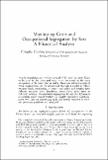| dc.contributor.author | Goldin, Claudia | |
| dc.date.accessioned | 2009-03-17T17:46:25Z | |
| dc.date.issued | 1986 | |
| dc.identifier.citation | Goldin, Claudia. 1986. Monitoring Costs and Occupational Segregation by Sex: A Historical Analysis. Journal of Labor Economics 4(1): 1-27. | en |
| dc.identifier.issn | 0734-306X | en |
| dc.identifier.uri | http://nrs.harvard.edu/urn-3:HUL.InstRepos:2666727 | |
| dc.description.abstract | Female manufacturing workers around 1900 were far more likely to be paid by the piece and were rarely employed at the same occupation in the same firm as males. These and related aspects of work organization can be understood through a model in which workers shirk, monitoring is costly, and males and females have different turnover rates. Employers adopt either piece rates or deferred payment. Occupational segregation by sex and differences in earnings result even if workers are equally productive. Establishment-level data on supervising male and female workers in time- and piece-rate positions are examined. | en |
| dc.description.sponsorship | Economics | en |
| dc.language.iso | en_US | en |
| dc.publisher | University of Chicago Press | en |
| dc.relation.isversionof | http://dx.doi.org/10.1086/298091 | en |
| dc.relation.hasversion | http://www.jstor.org/stable/2534874 | en |
| dash.license | LAA | |
| dc.title | Monitoring Costs and Occupational Segregation by Sex: A Historical Analysis | en |
| dc.relation.journal | Journal of Labor Economics | en |
| dash.depositing.author | Goldin, Claudia | |
| dc.identifier.doi | 10.1086/298091 | * |
| dash.contributor.affiliated | Goldin, Claudia | |


